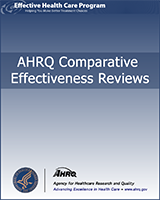This publication is provided for historical reference only and the information may be out of date.
Comparative Effectiveness of Nonoperative and Operative Treatments for Rotator Cuff Tears
Comparative Effectiveness Reviews, No. 22
Authors
Research Team: Jennifer C Seida, MPH, Project Coordinator, Janine R Schouten, BSc, Shima S Mousavi, MD, Lisa Tjosvold, MLIS, Ben Vandermeer, MSc, Andrea Milne, BScN, Kenneth Bond, BEd, MA, and Lisa Hartling, BScPT, MSc. Clinical Investigators: Claire LeBlanc, MD, FRCPC and David M Sheps, MD, MSc, FRCSC.1Affiliations
Excerpt
The objective of this review is to provide a comprehensive synthesis of the evidence examining the effectiveness of nonoperative and operative interventions for the treatment of rotator cuff tears. The report is intended for a broad audience, including professional societies developing clinical practice guidelines, patients and their care providers, as well as researchers conducting studies on treatments of this condition. Outcomes of interest include health-related quality of life, shoulder function, time to return to work, cuff integrity, pain, range of motion and strength of the shoulder.
Prepared for: Agency for Healthcare Research and Quality, U.S. Department of Health and Human Services.1 Contract No. 290-02-0023. Prepared by: University of Alberta Evidence-based Practice Center.
Suggested citation:
Seida J, Schouten J, Mousavi S, Tjosvold L, Vandermeer B, Milne A, Bond K, Hartling L, LeBlanc C, Sheps D. Comparative Effectiveness of Nonoperative and Operative Treatment for Rotator Cuff Tears. Comparative Effectiveness Review No. 22. (Prepared by the University of Alberta Evidence-based Practice Center under Contract No. 290-02-0023.) AHRQ Publication No. 10-EHC050. Rockville, MD: Agency for Healthcare Research and Quality. July 2010. Available at: www.effectivehealthcare.ahrq.gov/reports/final.cfm.
This report is based on research conducted by the University of Alberta Evidence-based Practice Center (EPC) under contract to the Agency for Healthcare Research and Quality (AHRQ), Rockville, MD (Contract No. 290-02-0023). The findings and conclusions in this document are those of the author(s), who are responsible for its contents; the findings and conclusions do not necessarily represent the views of AHRQ. Therefore, no statement in this report should be construed as an official position of AHRQ or of the U.S. Department of Health and Human Services.
The information in this report is intended to help health care decision makers—patients and clinicians, health system leaders, and policymakers, among others—make well-informed decisions and thereby improve the quality of health care services. This report is not intended to be a substitute for the application of clinical judgment. Anyone who makes decisions concerning the provision of clinical care should consider this report in the same way as any medical reference and in conjunction with all other pertinent information, i.e., in the context of available resources and circumstances presented by individual patients.
This report may be used, in whole or in part, as the basis for development of clinical practice guidelines and other quality enhancement tools, or as a basis for reimbursement and coverage policies. AHRQ or U.S. Department of Health and Human Services endorsement of such derivative products may not be stated or implied.
None of the investigators have any affiliations or financial involvement that conflicts with the material presented in this report.
- 1
540 Gaither Road, Rockville, MD 20850. www
.ahrq.gov
